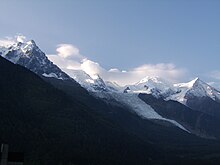This is an old revision of this page, as edited by Ottava Rima (talk | contribs) at 01:07, 8 October 2008 (small update, a start - 6 books and 4 articles to add). The present address (URL) is a permanent link to this revision, which may differ significantly from the current revision.
Revision as of 01:07, 8 October 2008 by Ottava Rima (talk | contribs) (small update, a start - 6 books and 4 articles to add)(diff) ← Previous revision | Latest revision (diff) | Newer revision → (diff)
Mont Blanc: Lines Written in the Vale of Chamouni is a poem by the Romantic poet Percy Bysshe Shelley composed between 22 July 1816 and 29 August 1816. It was first published in 1817 in History of a Six Weeks' Tour through a Part of France, Switzerland, German and Holland by Percy Shelley and Mary Shelley.
Background
"Mont Blanc" was written when Mary Godwin, Percy Shelley, and Claire Clairmont (Mary Godwin's half-sister by marriage), were touring the Chamonix Valley and visited Mont Blanc, Europe's highest mountain, at the end of July 1816. Shelley finished a draft of the poem before September, and the poem was first published in 1817 along with History of a Six Weeks' Tour. The published edition was not printed from the first finished copy of Shelley's poem, but instead from a second created after Shelley lost. This edition, with many differences from the first published edition, was discovered in December 1976.
The setting of the poem and the place Shelley was inspired to write the poem is a bridge over the Arve River in the Valley of Chamonix in Savoy, near Geneva. Mary Shelley wrote that the poem "was composed under the immediate impression of the deep and powerful feelings excited by the objects which it attempts to describe; and, as an undisciplined overflowing of the soul, rests its claim to approbation on an attempt to imitate the untamable wilderness and inaccessible solemnity from which those feeling sprang".
Poem
Variations
The first published edition varies from both the copy found in the Scrope Davies Notebook copy of the poem and the original manuscript draft in terms of language and philosophical view. An important distinction between the text is in the first published edition's line "But for such faith", which reads "In such a faith" in the Scrope Davies edition, with the manuscript agreeing with the Scrope Davies edition. The critic Michael O'Neill emphasizes that the Scrope Davies's version "makes the more evident sense, though it possibly sacrifices some of the tension" while the first published edition's version "is cryptic and tortuous, and yet the fact remains that Shelley chose to print the poem with this reading in his lifetime."
Themes
According to Romanticism scholar Duncan Wu, the poem is "Shelley's exploration of the nature of imaginative thought, and its relation to the nature world". It is a response to William Wordsworth's poem on the same topic, Tintern Abbey and a "defiant reaction" against the "religious certainties" of Samuel Taylor Coleridge's Chamouny, which "credits God for the sublime wonders of the landscape".
Critical response
Notes
References
- O'Neill, Michael. "Shelley's Lyric Art" in Shelley's Prose and Poetry, 2nd ed., Ed. Donald H. Reiman and Neil Fraistat, 616–626. New York: Norton and Co., 2002.
- Reiman, Donald H. and Fraistat, Neil. "Mont Blanc" in Shelley's Prose and Poetry, 2nd ed., Ed. Donald H. Reiman and Neil Fraistat, 96-97. New York: Norton and Co., 2002.
- Wu, Duncan. "Mont Blanc" in Romanticism: An Anthology, 2nd ed., Ed. Duncan Wu. Oxford: Blackwell, 1998.